Grove Park Depot
Grove Park Depot
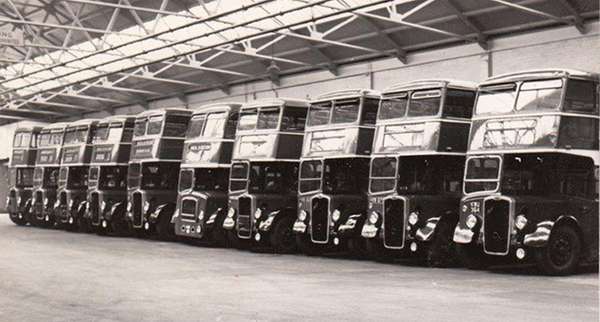
This is Grove Park depot, Harrogate, on a Sunday morning in 1962. It contains K6B, KS6B and KSW6B. The lone Lodekka is DX2, which was one of the test batch, pre-production. Although West Yorkshire fitted all their Lodekkas with standard short grilles, they couldn't disguise the fact that this was a pre-production one because it had a much squarer profile to the bonnet and lower windscreen. This was just a very common everyday sight, but what would we give now for these vehicles to still be with us?
David Rhodes
If you would like to comment on the above please click here
19/09/13 - 18:03
What a simply glorious picture David of the interior of the Harrogate "Temple of Excellence." One of the advantages of being "senior" is the ability to remember experiencing all these superb vehicles and indeed even many of their predecessors.
I always liked DX2 very much as it successfully set the standard for the Lodekka in general. 822 (DX1) was magical in its own way and with its reasonably traditional bonnet and wide radiator could not be disguised, nor would it want to be, and not forgetting its "K derived" bodywork also.
I feel sure that we shall never see such quality and innovation again, more's the pity.
Chris Youhill
19/09/13 - 18:03
I would be happy to just see the depot which is now a housing development with no hint of former glories. I recall with pleasure the sight of various examples of the Bristol/ECW combination lined up on the forecourt and the yard was always easy to get round at the weekend as well!
Chris Hough
20/09/13 - 07:20
Just been rummaging round in my files and found the fleet numbers of the vehicles in the Grove Park picture. Left to right: DB43, DBW26, DB63, DB9, DB5, DX2, DB53, DB41, DB52 and DBW8. The photograph was actually taken on 23rd September 1962.
David Rhodes
01/10/13 - 06:30
A wonderfully nostalgic picture David. Grove Park was one of my early 'discoveries' following our family move to Harrogate in 1966, and it always seemed to hold something of interest for the young bus spotter. Being the 'home' depot, it was also where any new vehicles were stored, pending their delivery to WY's body shop on nearby Westmoreland Street, for finishing touches prior to entering service. When my father started as a bus driver with the Company not long after we had moved, he would jot details of any new arrivals down for me - often on the back of a 'Capstan' cigarette packet, old envelope, or scrap of paper. He also introduced my brother and I to some of the engineering and cleaning staff, enabling us to have a wander around the depot from time to time when it was quiet. We always sought permission, and received the usual reply from the superintendent or foreman - "Yes you can lads, but be very careful, and don't go falling down any holes!". Imagine that nowadays. We felt very privileged to be able to amble around Grove Park, and I can still picture its vastness in my mind's eye. Thank you for posting, David.
Brendan Smith
01/10/13 - 17:52
Lovely photo inside the Harrogate depot; my folks moved back to the UK in 1979 after twenty plus years in Canada, and set up house initially in Harrogate. They weren't very far along the Skipton Road from this splendid building, and on my first visit there a few months after they'd got themselves settled, I stumbled across the depot within a couple of days. I recall the Bristol K converted to a tree lopper and painted all-over green was a regular fixture on the garage forecourt; it was by far the oldest resident.
This photo reminds me very much of a view in a copy of 'Buses Illustrated' from around the same year this was taken, illustrating an article on a very old chassis from a West Yorkshire vehicle that was being restored by apprentices at Grove Park, with the lads responsible posed for a picture with a line of Lodekkas parked up behind them.
Dave Careless
02/10/13 - 15:22
Following up on Dave Careless' submission regarding Grove Park, perhaps the attached photos of a vehicle I saw at Brislington in August will make sense. This vehicle caused quite a stir and the chassis that it's carrying is an exhibition unit and is the one which was restored by the WY apprentices. I assume that this belongs to Bristol Museum. I did hear some years ago that the WY apprentices ditched its bodywork as beyond repair, which caused a bit of an upset. No doubt these days with some of the superb restorations going on it would have been restored completely. Re the WY tree lopper, I think it still exists somewhere hidden away. Let's hope it doesn't go the same way as the preserved KDB went.
David Rhodes
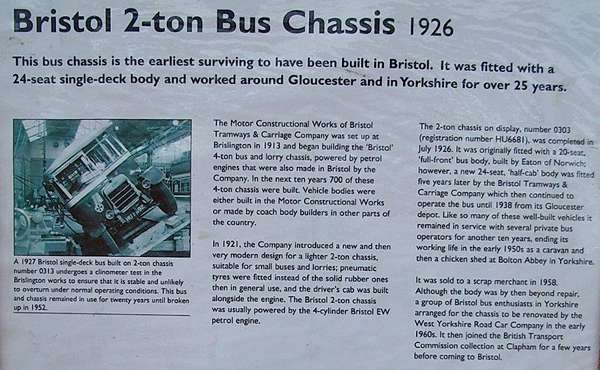

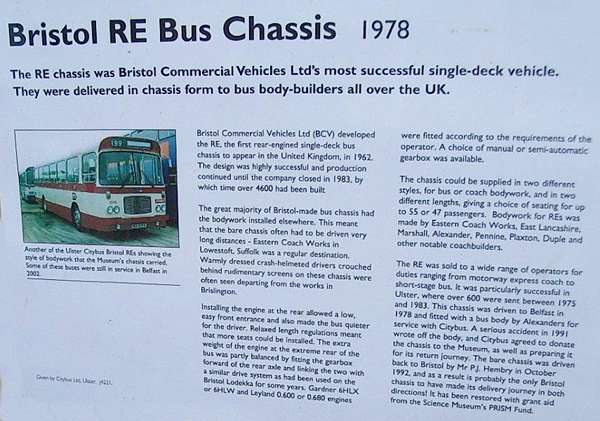
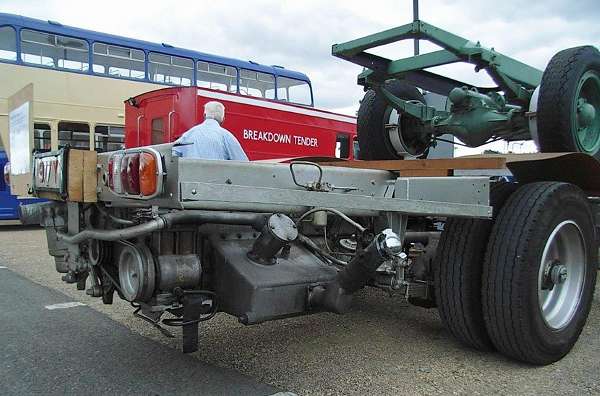
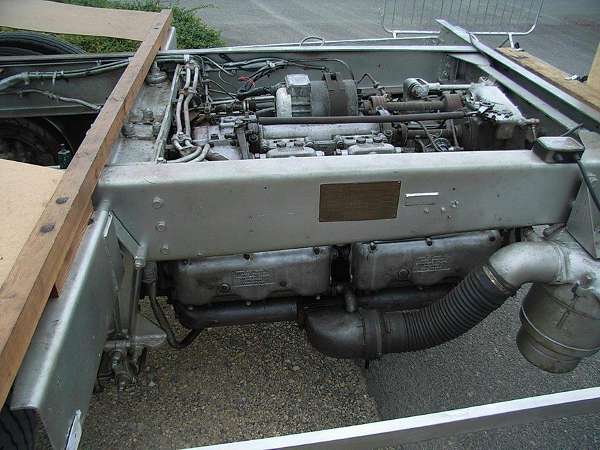
02/10/13 - 15:25
Dave C mentions an activity which seems to have ceased, namely tree-lopping by bus companies. Does it still go on and, if so, is it now the councils. I've never seen any tree-lopping going on for years.
Chris Hebbron
05/10/13 - 08:28
Dave and David, your mention of the chassis restored by West Yorkshire apprentices has fired me up. On looking through the June 1962 issue of 'Buses Illustrated' (thanks for the prompt Dave) the restoration article states that the chassis is a 1926 Bristol 2-ton model (Chassis No.0303). It was a former Bristol Tramways vehicle (HU6618) and was previously thought to have been scrapped in 1938. Originally built to normal control layout, it sported a 20-seat bus body by Bristol's 'Motor Constructional Works' when new. However, in 1931, the chassis was converted to forward control and a new 24-seat Motor Constructional Works body was fitted.
According to the article, it was used for workman's transport by a Birmingham company during World War II. In 1947 it was sold to a Mr A E Harris of Birmingham who drove it up to Ingleton in Yorkshire, and converted it to a 'summer living caravan'. In 1951 Mr Harris drove the little 2-tonner down the dale to Bolton Abbey near Skipton, and ownership passed to his son. The bus was rescued from the breaker's torch by John Cockshott, M H Heard and three fellow enthusiasts, two of whom lived in Bristol.
The article also states that "As the body was in poor order and would evidently need extensive rebuilding, it was decided that work on the vehicle's restoration should commence with the chassis, which was in much better condition". When the body was removed from the chassis, "the problem of the restoration of the body was somewhat sadly resolved as it disintegrated upon removal, all the woodwork, which had been considerably modified by its various owners, being rotten".
The photos of the chassis as restored by the WY apprentices, looks an absolute credit to all concerned. One of the apprentices in the picture looks suspiciously like Dennis Boot, who went on to become WY Central Works chassis shop foreman, and in later years chassis shop superintendent, until the works closed following 'privatisation' in the late 1980's. Obviously taking part in restoring the Bristol 2-tonner stood him in good stead! The restoration is also a credit to the foresight of the enthusiasts concerned, who ensured that a rarity such as 0303 was rescued and saved for posterity, in the days when bus preservation was in its infancy.
Brendan Smith
06/10/13 - 14:26
The additional information on the old 'B.I.' photograph of the apprentices is fascinating, thanks Brendan. Those early enthusiasts did indeed show remarkable foresight in saving the machine from the scrapman's torch. The comment that the body disintegrated on removal is certainly no exaggeration as can be seen by one of the other views illustrating the article! The apprentices in the picture look very reminiscent of the early sixties era; three years later and likely their hair would have been down over their ears and brushed forward!!
Dave Careless
13/11/13 - 06:33
Dave, the lovely old tree lopper did indeed seem to be a regular fixture on Grove Park's forecourt. It was for many years as you say, the oldest vehicle in the fleet (Mind you, WY's wartime AEC Matador recovery vehicle 1022/4022 (TWW 133), also based at Grove Park, ran it a close second). Originally built in 1937, it entered West Yorkshire service as 359 (BWY 991), a standard Bristol K5G with ECW 53-seat lowbridge bodywork. After World War II it was one of the vehicles included in WY's K-type 'rehab' programme, having its chassis overhauled at Central Works (including fitment of the later, lower PV2 radiator) before being dispatched to ECW in 1949 for the fitting of a new 55-seat lowbridge body. It was renumbered DG13 in 1954 and withdrawn from passenger service in 1959. The body was then rebuilt in WY's Body Shop to enable it to be used as a tree lopper, as shown in the accompanying photos.

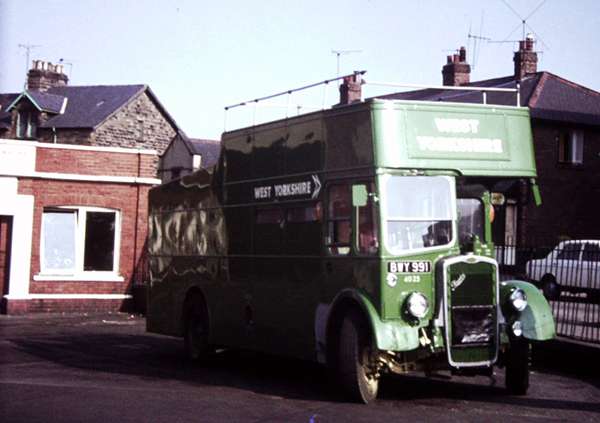
Behind the front bulkhead, covered accommodation for the crew was provided, accessed by a new forward entrance. The 'deck' above the cab, canopy and crew accommodation then became the area used for tree lopping, with access gained from a flight of steps. What was the remainder of the lower deck was used as a loading area for transporting lopped foliage, rubbish/waste from Grove Park/Central Works to the local amenity tip, and carrying bins full of grit in winter, among other things. Access to the loading area was via a pair of hinged doors built into the rear bulkhead. A snowplough attachment could be fitted to the front in snowy weather, in order to clear Harrogate bus station and the depot forecourt etc, and a towing bracket was fitted at the rear. The old love just oozed character, and the reassuringly rhythmic sound of that 5-pot Gardner ticking over was a joy to behold.
David, the tree lopper was sold (via North's) to a Mr Shepherd at Bishop Thornton, and as far as I know is still in existence. I have heard from several people over the years that various offers have been made to the owner to sell it for preservation, but that the price asked by him has sadly been unrealistic. Whether the K is under cover, I don't know, but as you say, we can only hope it IS a survivor. A real shame it is not on the road, as it was a very faithful workhorse, always ready for duty no matter what.
Brendan Smith
13/11/13 - 12:55
Brendan, being very ancient I'm lucky enough to recall a glorious summer day in, perhaps, 1958/9 when I was a conductor at Ledgard's Otley/Ilkley depots. Due to the joint operation of the 34/77 Leeds - Otley - Ilkley service we were occasionally called upon to boost the crew of the good ship "WYRCC Treelopper." Well, I was called for by the WY chaps in the wonderful old predecessor to the K5G in the picture - this being a Leyland TD1/2 with 5 cylinder Gardner. After a glorious open air ride up the A660 we began to "lop" in the region of the Bar House and clipped wherever necessary through leafy Bramhope and on to Golden Acre Park - where my signet ring flew off due to my over exuberance and is no doubt still in the ground level foliage just prior to the Park Gates - anyone got a metal detector I could borrow ??
Chris Youhill
13/11/13 - 16:08
Chris, there is a photo of your Leyland steed in issue 675 of the West Yorkshire Information Service bulletin, with a chap in overalls precariously standing on the front dome, while lopping what appears to be quite a substantial bough level with his head! The caption reads "'Elf'n'safety? What's that? The predecessor of the K5G tree lopper was this Leyland TD2, numbered 1008 and also Gardner 5LW powered". I've often wondered whether any council horticultural staff or tree surgeons accompanied bus company employees to carry out the pruning/lopping, or if the task was simply carried out by willing company staff with a keen interest in gardening.... Does anyone know? Also, who is responsible for lopping trees nowadays? I can't remember the last time I saw a bus company tree lopper, but have noted quite a few modern 'deckers in recent years wearing those ugly-looking 'tree defenders' on their nearside front upper deck pillar. Presumably this indicates lopping (like railway track weeding) is no longer carried out as often as it should be.
Brendan Smith
15/11/13 - 10:12
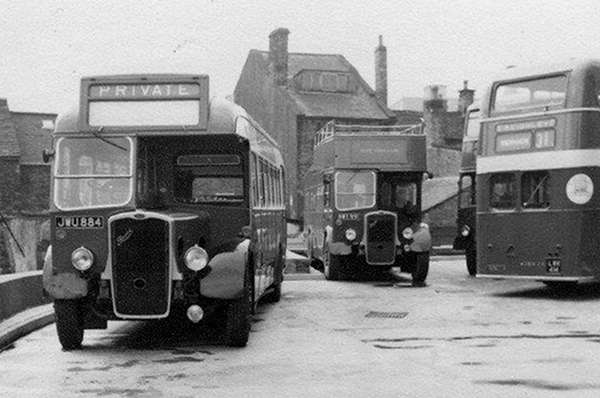
We seem to have crossed over interestingly to the tree lopper, which was kept at Harrogate. Above is a photo, of this vehicle on the front apron of Keighley depot in October 1965, so this makes me speculate about how they operated this vehicle. Obviously a Harrogate driver must have been in charge, but when it was away working at a distance what staff were used to do the tree work? Were they spare drivers, fitters?
Somewhere I have a photo of the previous tree lopper and I'll put it on here when I come across it.
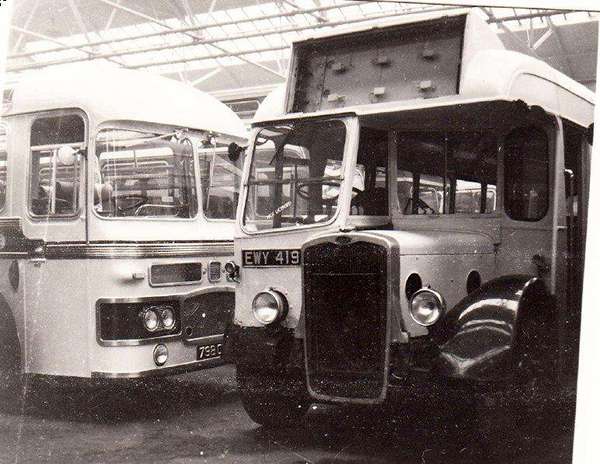
Regarding vehicles tucked away inside at the back of Grove Park depot, here is a photo of L5G, SG103, which was WY's only conversion of an L5G to pay-as-you-enter with a front door. This was quite a surprise when I saw it because it was being prepared for sale to Fowler's Contractors who were WY's main building company. It was so gloomy in the back of the depot that the negative from this photo was virtually unprintable, but thanks to the patience of John Fozard, it was salvaged.
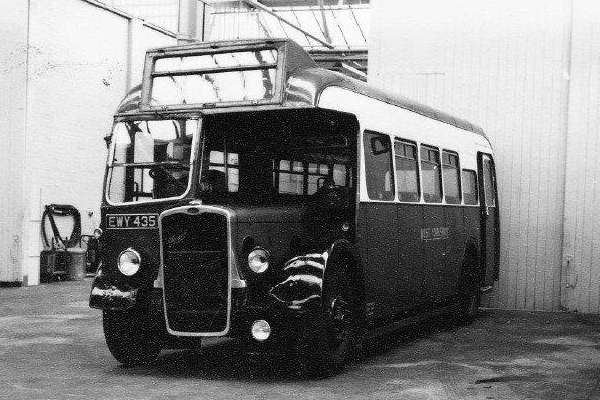
This is a photo showing L5G no. SG119. I've put it on site just to show the high standard to which these vehicles were maintained. This photo is dated 23.10.62 and I doubt this vehicle had much longer to go before being sent for scrap. The paint finish puts many modern fleets to shame.
David Rhodes
15/11/13 - 17:33
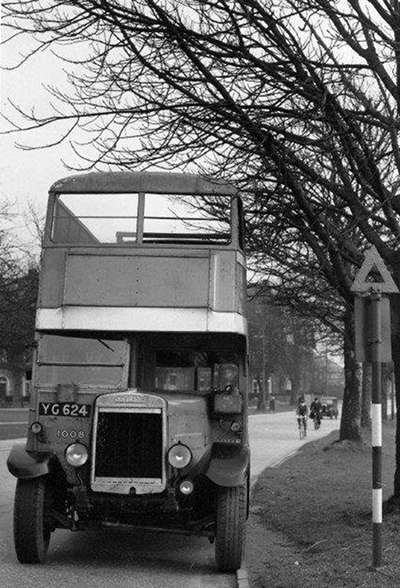
Here is a picture of the old tree lopper. What a shame it didn't survive. I believe the photograph was originally a company one, hence it's posing ready for action.
David Rhodes
16/11/13 - 15:28
A question for all WYRCC experts. Why did West Yorkshire paint their ancillary fleet green rather than red and why did they paint the cream bands on old stock green as well. This has intrigued me for years.
Chris Hough
17/11/13 - 06:59
In reply to Chris Hough's puzzle, the cream bands were painted out (or rather, daubed)with a liberal coat of pea green when out of stock for disposal. I suppose it made sure that these vehicles were not in a Tilling livery and were therefore unlikely to be mistaken as West Yorkshire vehicles. The other question regarding why service vehicles were green I can't answer. Again, perhaps it was to avoid confusion on the public's part. Putting your hand out for the tree lopper to stop could be a bit of a surprise!
I have heard that converted tow car KWU 383 has been saved. Does anyone know any more about this?
Regarding green paint, I always wondered why the cabs were always painted out in green. Someone once suggested that it was a more relaxing colour, but I don't think such a consideration would be made.
David Rhodes
18/11/13 - 05:19
David Former West Yorkshire tow car 4044 LWR424 a former Bristol KSW numbered DGW4 is preserved and can be seen at www.sct61.org.uk
Chris Hough
18/11/13 - 05:21
Arriva also Obliterates vehicles when selling them. When a batch of Volvo City Buses were withdrawn by Arriva Yorkshire the painter applied Brown Paint. He actually used Floor paint. I think this practise started after Hunter Coaches in Leeds had a number of ex Maidstone Metro buses and ran them in Arriva Aquamarine.
Philip Carlton
20/11/13 - 16:23
Chris, I think David is probably on the right lines re WYRCC painting its service vehicles green in order to make them readily identifiable to the bus-using public, especially if a service vehicle still had something of a 'bus silhouette' when approaching. I believe the green scheme was adopted in the 1950's, but interestingly when the Lodekka driver training buses were introduced, they retained standard Tilling red and cream livery (later NBC poppy red and white) - identical in fact to the operational fleet! Also, the Central Works Engineers van (1039) and Traffic Department van (1040) delivered in 1969, were painted in an attractive livery of 'coach' maroon and cream, presumably in honour of their status as 'Head Office' vehicles! The service vehicle livery changed to poppy red in 1980, with all subsequently-acquired vans, trucks and lorries being so treated.
The overpainting of fleetnames, fleetnumbers and cream bands was used to identify vehicles awaiting disposal - usually to North's at Sherburn-in-Elmet. Sometimes withdrawn vehicles were stored still wearing full livery for a while, and occasionally some of these were reinstated for a short period in times of need (late delivery of new vehicles for example). Painting the cream bands green would therefore indicate to North's and WY depot staff at a glance which vehicles were ready to be disposed of.
Returning to service vehicles, I am reminded of the time Bradford depot was without a 'proper' towing vehicle. Pending the eventual entry into service of towing lorry 4044 (converted from KSW6G DGW4: LWR424), withdrawn LS5G SMG2 (LWR432) was commissioned to fill the breach. Becoming 1038 it retained its seats, but had its boot doors removed and a rear towing bracket fitted for its new role as temporary towing vehicle. The cream window surrounds were duly painted green and it was despatched to Bradford. Some while later however, it was discovered that 1038 was "back in revenue earning service" in its new 'livery', complete with doorless boot and towing bracket!! To say that Chief Engineer WG (Bill) Stephen was incandescent with rage when he found out was something of an understatement - and here was a man who was usually very calm and collected. As a result most of 1038's seats were removed immediately and strict instructions given that the LS5G was for use as a towing vehicle only. Good job they hadn't been loaned the tree-lopper....
Brendan Smith
Comments regarding the above are more than welcome please get in touch via the 'Contact Page' or by email at obp-admin@nwframpton.com
All rights to the design and layout of this website are reserved
Old Bus Photos from Saturday 25th April 2009 to Wednesday 3rd January 2024